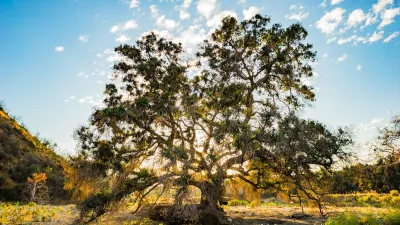Louis Sagahun explores the unexpected benefits of trading 5,000 square feet of grass and pavement for native plants at a Los Angeles elementary school.
Located deep in the concrete jungle just west of Downtown Los Angeles, Leo Politi Elementary School has witnessed a transformation in student learning and engagement. Like so many inner-city schools, it suffered from low test scores and a dreary landscape – that is, until a grant from the U.S. Fish and Wildlife Service brought a natural habitat onto the schoolyard.
After crews tore up 5,000 square feet of blacktop and replaced it with native flora, bugs shortly followed. After bugs came birds, and after birds came children. Marveled by the natural processes taking place on the playground, the children found a real-life experience against which to anchor their scientific curiosity, leading the school to an astronomical improvement on test scores in science.
Whereas three years ago, only one in eleven students tested "proficient" in science (and none ranked "advanced"), now more than half perform at those levels.
"Questions about why some birds flocked to one plant and not another led to discussions about soil composition and water cycles, weather patterns and seasons, avian migration and the tilt of the Earth in its orbit around the sun," said principal Brad Rumble.
And as lead arts and humanities teacher Robert Jeffers explains, the benefits extend beyond scientific understanding. The habitat has "instilled a profound sense of responsibility and awareness of nature," Jeffers said. "Now these kids can tell the difference between a crow and a raven, which requires cognitive skills of understanding subtleties and nuances important throughout life."
FULL STORY: At an urban L.A. school, nature grows — and test scores too

Planetizen Federal Action Tracker
A weekly monitor of how Trump’s orders and actions are impacting planners and planning in America.

The Simple Legislative Tool Transforming Vacant Downtowns
In California, Michigan and Georgia, an easy win is bringing dollars — and delight — back to city centers.

San Francisco's School District Spent $105M To Build Affordable Housing for Teachers — And That's Just the Beginning
SFUSD joins a growing list of school districts using their land holdings to address housing affordability challenges faced by their own employees.

In More Metros Than You’d Think, Suburbs are Now More Expensive Than the City
If you're moving to the burbs to save on square footage, data shows you should think again.

The States Losing Rural Delivery Rooms at an Alarming Pace
In some states, as few as 9% of rural hospitals still deliver babies. As a result, rising pre-term births, no adequate pre-term care and "harrowing" close calls are a growing reality.

The Small South Asian Republic Going all in on EVs
Thanks to one simple policy change less than five years ago, 65% of new cars in this Himalayan country are now electric.
Urban Design for Planners 1: Software Tools
This six-course series explores essential urban design concepts using open source software and equips planners with the tools they need to participate fully in the urban design process.
Planning for Universal Design
Learn the tools for implementing Universal Design in planning regulations.
Smith Gee Studio
City of Charlotte
City of Camden Redevelopment Agency
City of Astoria
Transportation Research & Education Center (TREC) at Portland State University
US High Speed Rail Association
City of Camden Redevelopment Agency
Municipality of Princeton (NJ)





























